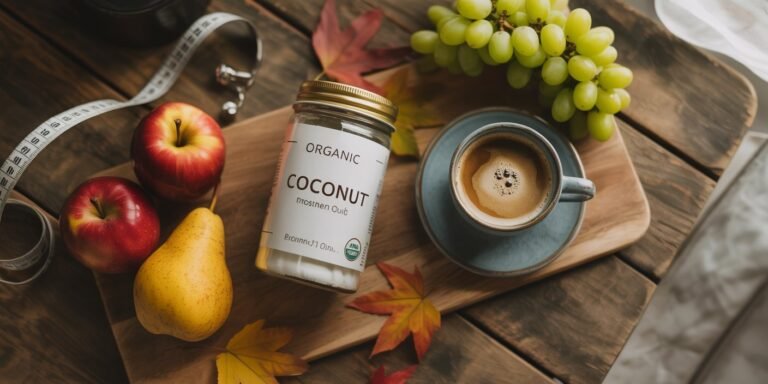We’ve all heard the saying, “You are what you eat,” and when it comes to living a healthier, more energetic life, this couldn’t be more true.
Healthy food is the foundation of good health, fueling your body with the nutrients it needs to perform at its best — physically, mentally, and emotionally.
Eating healthy doesn’t just mean sticking to salads or cutting out all your favorite treats. It’s about making balanced, sustainable choices that nourish your body while still allowing room for enjoyment.
Whole foods like fruits, vegetables, lean proteins, whole grains, and healthy fats provide vitamins, minerals, fiber, and antioxidants that help fight disease, support a strong immune system, and boost energy levels.
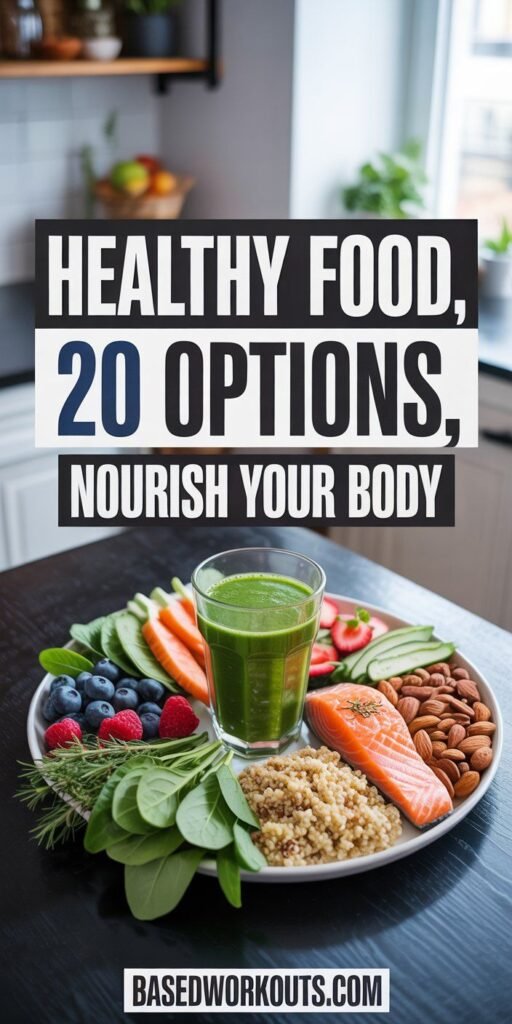
Unlike processed foods loaded with sugar, salt, and unhealthy fats, nutrient-dense meals keep your body satisfied and your metabolism working efficiently.
The result? Better weight management, improved digestion, glowing skin, and even enhanced mental clarity.
Another beautiful thing about healthy food is its versatility. Whether you’re cooking a quick weeknight dinner, prepping snacks for work, or planning festive holiday meals, there are endless ways to make nutritious meals both delicious and exciting.
Simply put, making healthier food choices isn’t a diet — it’s a lifestyle shift that sets you up for long-term wellness, helping you feel stronger, lighter, and more energized every day.
1. Avocados
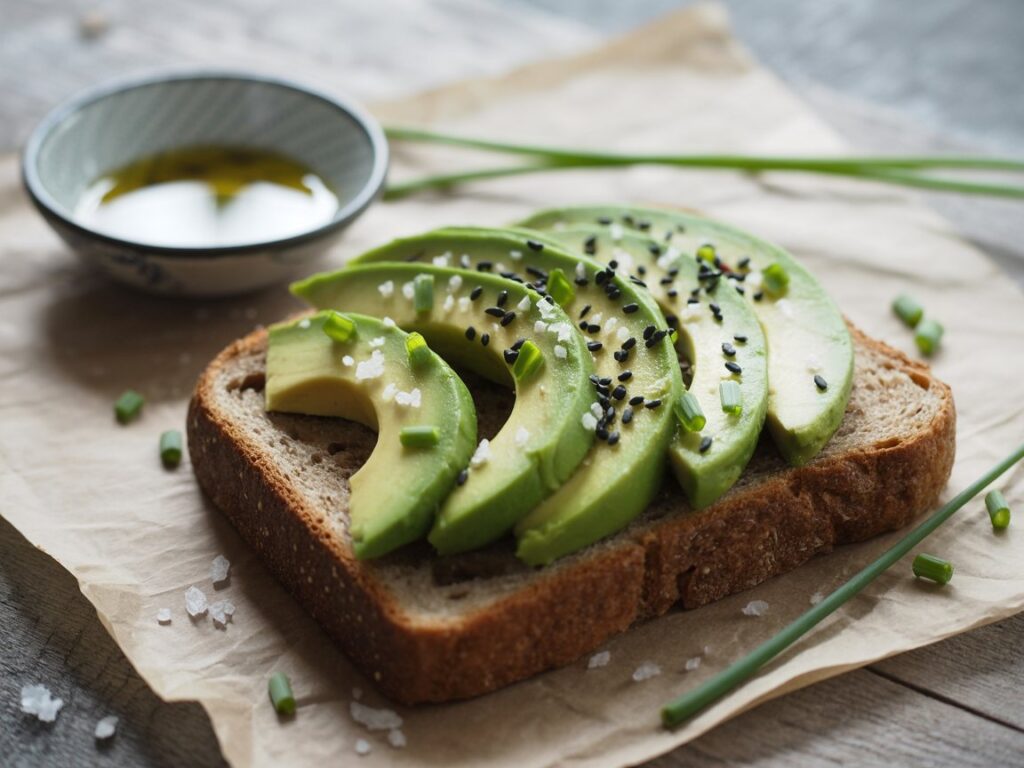
Avocados have gone from being a trendy brunch item to a true superfood staple in kitchens around the world.
But they’re not just creamy and delicious — they’re packed with healthy fats, vitamins, minerals, and antioxidants that benefit your heart, skin, digestion, and even weight management.
Whether you’re trying to eat healthier, lose weight, or just add more nutrient-dense foods to your diet, avocados are a simple and versatile choice.
The Nutrition Breakdown of Avocados
Here’s what makes avocados such a powerful food:
- Healthy fats (monounsaturated fats): Support heart health, reduce bad cholesterol, and keep you fuller longer.
- Potassium: Even more than bananas. Helps regulate blood pressure and reduce bloating.
- Fiber: Aids digestion, controls appetite, and supports gut health.
- Vitamins & Antioxidants: Rich in Vitamin E, Vitamin C, Vitamin K, and folate, which protect skin, boost immunity, and support cell repair.
Health Benefits of Avocados
- Supports Heart Health – The monounsaturated fats in avocados help lower “bad” LDL cholesterol and increase “good” HDL cholesterol.
- Boosts Skin and Hair Glow – Vitamin E and healthy fats nourish your skin and keep it hydrated from the inside out.
- Helps with Weight Management – Thanks to fiber and healthy fats, avocados keep you satisfied and prevent overeating.
- Improves Digestion – High fiber content supports gut health and regular bowel movements.
- Great for Eye Health – Avocados contain lutein and zeaxanthin, antioxidants that protect your eyes from damage.
How to Eat Avocados (Simple & Delicious Ideas)
- Classic Avocado Toast – Whole-grain bread topped with mashed avocado, chili flakes, and lemon juice.
- Salad Topping – Add sliced avocado to your favorite salad for creaminess and extra nutrients.
- In Wraps and Bowls – Perfect for burrito bowls, tacos, or Mediterranean wraps.
- Smoothies – Blend half an avocado with spinach, banana, and almond milk for a creamy, nutrient-dense smoothie.
- With Eggs – Pair avocado slices with scrambled eggs or omelets for a protein and healthy fat breakfast.
- Avocado Desserts – Use ripe avocados in chocolate mousse, pudding, or even ice cream for a healthy twist.
Pro Tips for Buying and Storing Avocados
- Choose slightly soft avocados for immediate use. If they’re firm, leave them at room temperature to ripen.
- To speed up ripening, place them in a paper bag with a banana or apple.
- Once ripe, store in the fridge to prevent over-ripening.
- To save half an avocado, sprinkle with lemon juice and store in an airtight container to prevent browning.
Final Thoughts
Avocados are more than just a tasty food — they’re a nutrient powerhouse that supports overall health, from heart function to skin glow.
Adding them to your daily meals in moderation can help you feel full, energized, and nourished.
Whether on toast, in smoothies, or as part of a hearty salad, avocados prove that healthy eating can be delicious too.
2. Leafy Greens
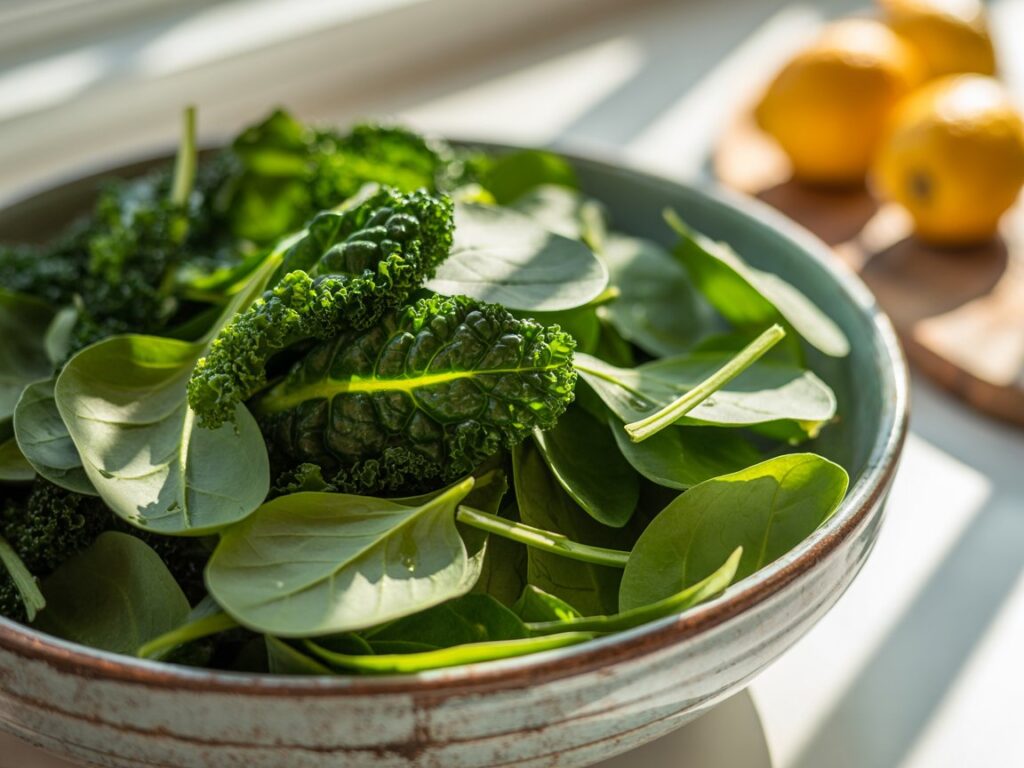
Leafy greens are some of the most nutrient-dense foods on the planet. They’re low in calories but packed with vitamins, minerals, antioxidants, and fiber — making them a cornerstone of any healthy diet.
From spinach and kale to arugula and collard greens, these vegetables offer a wide range of health benefits that support everything from digestion to heart health.
If you’re looking to improve your diet, manage your weight, or simply feel more energized, leafy greens are an easy and versatile food to include in your daily meals.
The Nutrition Profile of Leafy Greens
While each type of leafy green has its own strengths, they share some key nutrients:
- Vitamin K: Essential for bone strength and healthy blood clotting.
- Vitamin A and Beta-Carotene: Supports vision and immune function.
- Vitamin C: Boosts immunity, helps collagen production, and protects against oxidative stress.
- Iron and Calcium: Crucial for energy levels and bone health.
- Fiber: Supports digestion, weight management, and gut health.
- Antioxidants: Reduce inflammation and protect against chronic disease.
Health Benefits of Leafy Greens
- Supports Heart Health – The potassium and nitrates in leafy greens help regulate blood pressure and improve circulation.
- Aids Weight Management – Low in calories and high in fiber, they keep you full while supporting fat loss.
- Improves Bone Strength – Rich in calcium and vitamin K, leafy greens help prevent bone loss.
- Boosts Skin Health – Vitamin A and antioxidants reduce skin damage and support a youthful glow.
- Reduces Inflammation – Phytonutrients and antioxidants help calm inflammation and protect against disease.
Easy Ways to Add Leafy Greens to Your Meals
- Smoothies: Blend spinach or kale into fruit smoothies for extra nutrients without overpowering the flavor.
- Salads: Combine arugula, romaine, or mixed greens with healthy toppings like avocado, nuts, and lean protein.
- Soups and Stews: Add collard greens, kale, or spinach to soups for more fiber and vitamins.
- Wraps: Use large collard or lettuce leaves as a low-carb wrap alternative.
- Side Dishes: Sauté spinach, Swiss chard, or kale with olive oil, garlic, and lemon for a simple side.
- Egg Dishes: Add spinach or kale to omelets, frittatas, or scrambled eggs.
Pro Tips for Buying and Storing Leafy Greens
- Look for vibrant, crisp leaves without yellowing or wilting.
- Store greens in the refrigerator in a breathable produce bag or wrapped in paper towels to absorb moisture.
- Wash just before use, not before storing, to extend freshness.
- Frozen spinach and kale are excellent options for cooking and smoothies.
Final Thoughts
Leafy greens are among the healthiest foods you can eat. By adding them to your meals daily, you can improve digestion, strengthen bones, protect your heart, and fuel your body with essential nutrients.
Simple, affordable, and versatile, leafy greens prove that the foundation of a healthy diet can also be delicious and satisfying.
3. Salmon
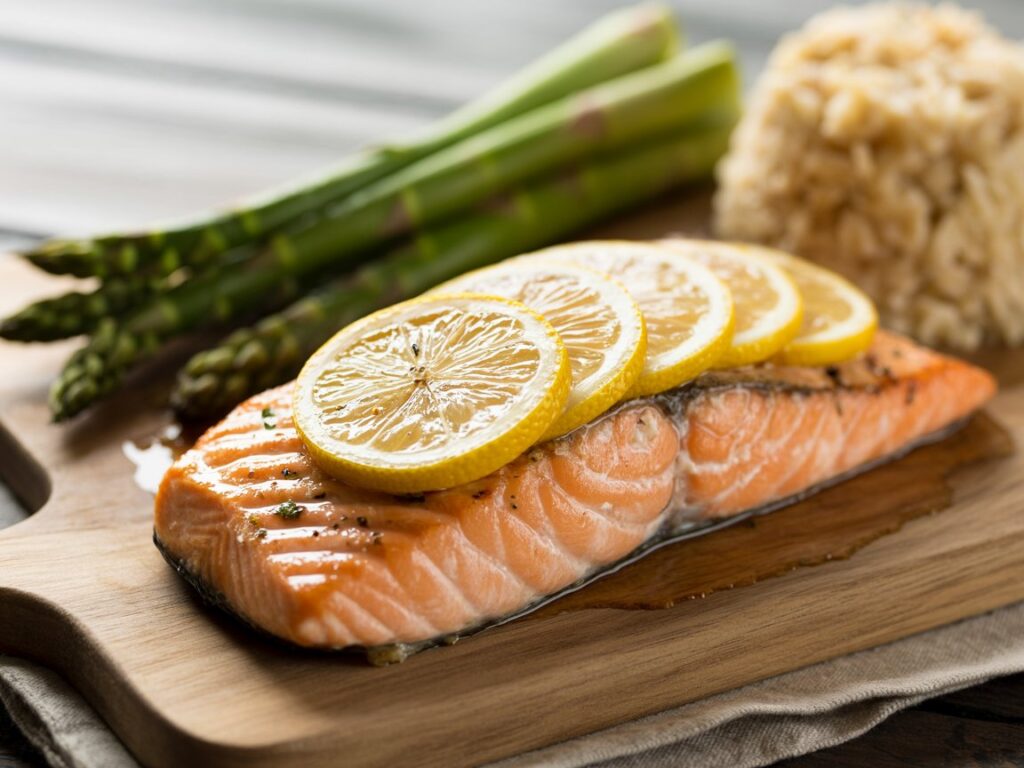
Salmon is one of the most nutritious and versatile foods you can add to your diet. Known for its rich flavor and soft, flaky texture, salmon is packed with high-quality protein, omega-3 fatty acids, vitamins, and minerals.
These nutrients work together to support heart health, brain function, skin glow, and overall energy levels.
Whether baked, grilled, smoked, or pan-seared, salmon makes it easy to enjoy a meal that is both satisfying and incredibly good for you.
The Nutrition Profile of Salmon
Here’s why salmon is considered one of the healthiest proteins:
- Protein: About 20–25 grams of high-quality protein per serving, essential for muscle growth and repair.
- Omega-3 Fatty Acids (EPA and DHA): Reduce inflammation, improve brain health, and support heart function.
- Vitamin D: Crucial for strong bones, immunity, and mood regulation.
- Vitamin B12: Supports nerve health and energy production.
- Selenium: A powerful antioxidant that protects cells from damage.
- Potassium: Helps regulate blood pressure and reduce bloating.
Health Benefits of Salmon
- Supports Heart Health – Omega-3 fatty acids help lower blood pressure, reduce cholesterol, and improve circulation.
- Boosts Brain Function – DHA in salmon supports memory, focus, and long-term brain health.
- Promotes Healthy Skin and Hair – Omega-3s and antioxidants reduce dryness and keep skin glowing.
- Strengthens Bones and Joints – Rich in vitamin D and protein, salmon helps support bone density and joint health.
- Aids Weight Management – High in protein and healthy fats, salmon keeps you full and reduces cravings.
- Reduces Inflammation – Regular consumption may lower the risk of chronic diseases linked to inflammation.
Best Ways to Eat Salmon
- Grilled Salmon: Season with herbs and lemon for a light, healthy meal.
- Baked Salmon: Roast with olive oil, garlic, and vegetables for an easy weeknight dinner.
- Smoked Salmon: Perfect for bagels, salads, or as a protein-packed snack.
- Salmon Bowls: Combine with rice, avocado, and leafy greens for a balanced meal.
- Salmon Patties: A creative way to use canned salmon for high-protein meals.
- Salmon with Pasta: Toss with whole-grain pasta, spinach, and olive oil for a nutrient-rich dish.
Pro Tips for Buying and Storing Salmon
- Choose wild-caught salmon when possible, as it generally has higher omega-3 content and fewer additives.
- Look for firm, moist flesh with a fresh smell.
- Store fresh salmon in the refrigerator and cook within 1–2 days.
- Freeze portions if you don’t plan to use them right away.
- Canned salmon is an affordable and convenient option that still provides many of the same benefits.
Final Thoughts
Salmon is more than just a delicious protein — it’s a nutrient powerhouse that benefits nearly every system in the body.
By adding it to your meals two to three times a week, you can improve heart health, support brain function, and fuel your body with high-quality protein and essential fats.
From quick weeknight dinners to festive holiday platters, salmon proves that eating healthy can be both simple and flavorful.
4. Quinoa
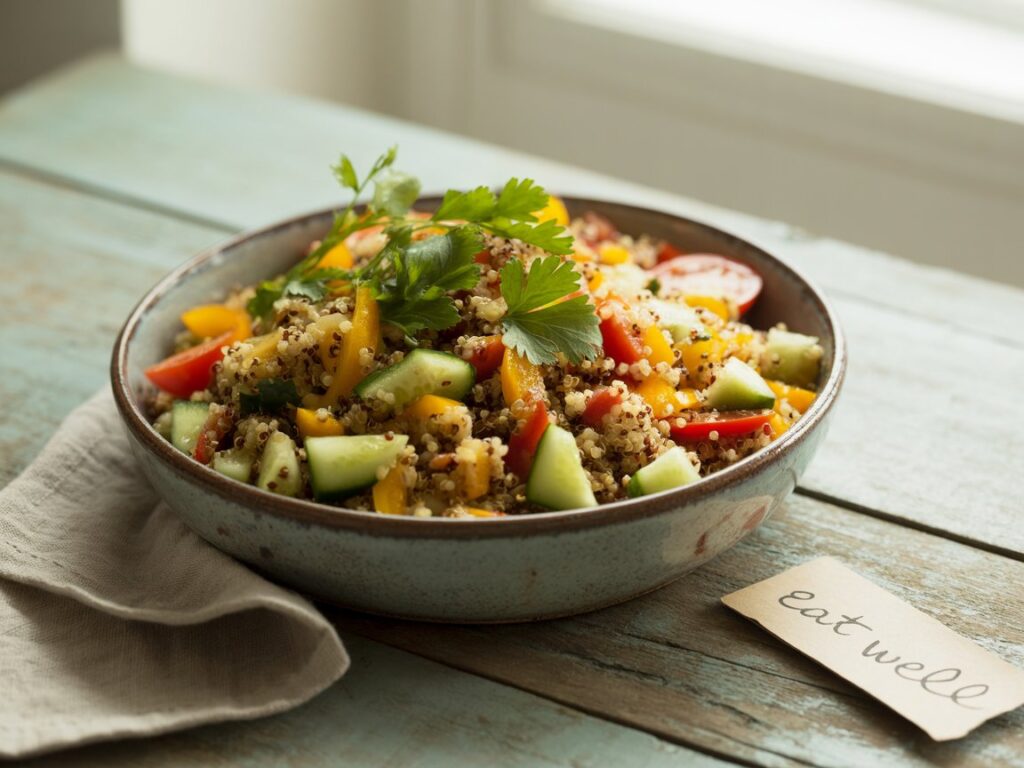
Quinoa has become one of the most popular “superfoods” in recent years, and for good reason. This ancient grain, once a staple in South American diets, is gluten-free, protein-rich, and packed with vitamins and minerals.
Unlike most plant-based foods, quinoa is a complete protein, meaning it contains all nine essential amino acids that the body needs but cannot produce on its own.
Light, nutty, and versatile, quinoa can be used in salads, bowls, breakfast dishes, or even baked goods — making it a smart choice for anyone looking to eat healthier, manage weight, or fuel workouts naturally.
The Nutrition Profile of Quinoa
Here’s why quinoa stands out as a nutritional powerhouse:
- Protein: 8 grams per cup, including all essential amino acids.
- Fiber: 5 grams per cup, which helps digestion and satiety.
- Magnesium: Supports muscle and nerve function, as well as energy production.
- Iron: Helps transport oxygen in the blood and prevents fatigue.
- B Vitamins: Important for metabolism and energy.
- Antioxidants: Protect against cell damage and inflammation.
- Gluten-Free: Ideal for people with gluten intolerance or celiac disease.
Health Benefits of Quinoa
- Supports Muscle Growth and Repair – As a complete plant-based protein, quinoa is excellent for vegetarians, vegans, and athletes.
- Aids Digestion and Gut Health – Its fiber helps regulate digestion and supports healthy gut bacteria.
- Helps with Weight Management – High in protein and fiber, quinoa promotes satiety and helps reduce overeating.
- Stabilizes Blood Sugar – The low glycemic index makes quinoa a great choice for people managing blood sugar levels.
- Boosts Energy – Magnesium, iron, and B vitamins support overall energy and reduce fatigue.
- Reduces Inflammation – Quinoa’s antioxidants help fight oxidative stress and inflammation.
Delicious Ways to Eat Quinoa
- Quinoa Salad: Toss with vegetables, olive oil, and lemon juice for a light, refreshing dish.
- Quinoa Bowls: Pair with lean protein, leafy greens, and avocado for a balanced meal.
- Breakfast Quinoa: Cook with almond milk, cinnamon, and fruit for a warm, hearty breakfast.
- Quinoa Stir-Fry: Use in place of rice with vegetables and a protein of your choice.
- Quinoa Soup: Add to broths and stews for extra fiber and protein.
- Quinoa Baked Goods: Use quinoa flour in muffins, pancakes, or bread for added nutrition.
Pro Tips for Cooking and Storing Quinoa
- Rinse quinoa before cooking to remove its natural coating (saponin), which can taste bitter.
- Use a 2:1 ratio of water to quinoa and simmer until fluffy (about 15 minutes).
- Store cooked quinoa in the refrigerator for up to 5 days — perfect for meal prep.
- Freeze cooked quinoa in portions for quick and easy meals.
Final Thoughts
Quinoa is more than just a trendy health food — it’s a complete plant-based protein that can support energy, muscle repair, weight management, and overall wellness. Easy to cook and incredibly versatile, it can be enjoyed in both savory and sweet dishes.
By adding quinoa to your weekly meal plan, you’ll not only enjoy its nutty flavor and fluffy texture but also fuel your body with one of the healthiest grains available today.
5. Blueberries
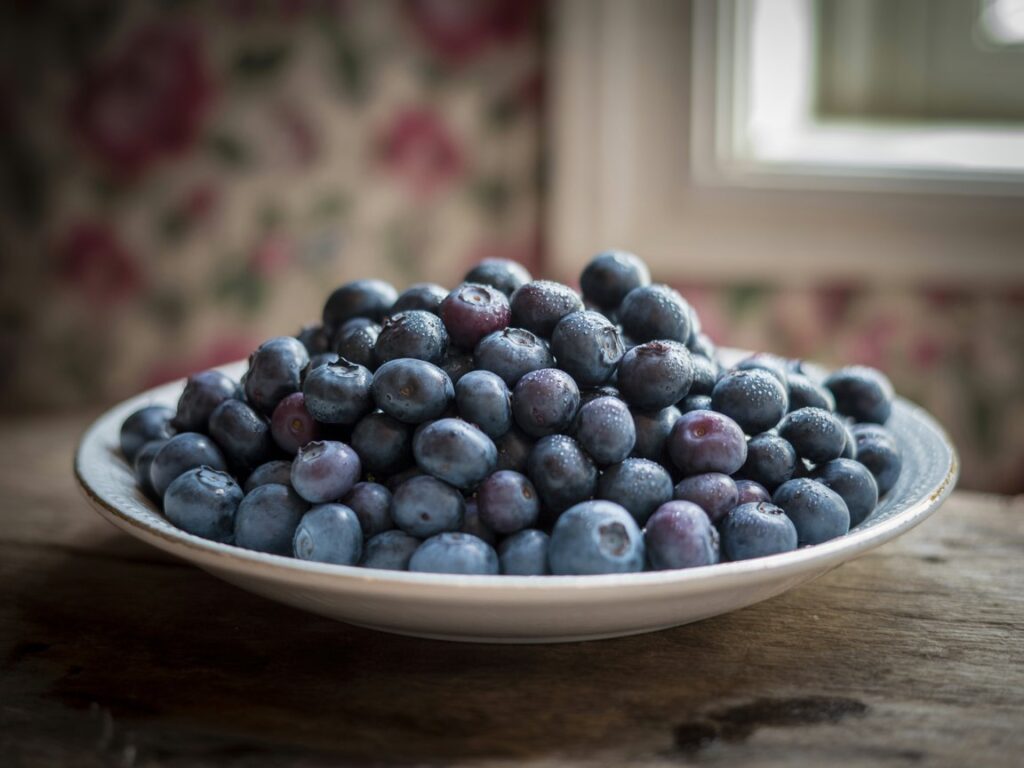
Blueberries are often called a “superfruit” — and for good reason. These tiny berries are packed with antioxidants, vitamins, and fiber that support brain health, heart function, digestion, and even skin glow.
They’re naturally sweet, low in calories, and easy to add to everything from smoothies to baked goods.
Whether you’re trying to improve overall wellness, manage weight, or simply enjoy a healthy snack, blueberries are one of the simplest and most powerful foods you can eat.
The Nutrition Profile of Blueberries
Blueberries may be small, but they’re nutrient-dense. Here’s what they provide:
- Antioxidants (anthocyanins): Protect cells from oxidative damage and inflammation.
- Vitamin C: Boosts immunity and supports skin collagen production.
- Vitamin K: Helps with bone strength and blood clotting.
- Fiber: Supports digestion and appetite control.
- Manganese: Aids metabolism and energy production.
- Low Calories: About 80 calories per cup, making them ideal for weight management.
Health Benefits of Blueberries
- Boosts Brain Health – Antioxidants in blueberries improve memory, focus, and long-term brain function.
- Supports Heart Health – Regular consumption may lower blood pressure and improve cholesterol levels.
- Aids Weight Management – Low-calorie, high-fiber content keeps you full while reducing cravings.
- Improves Skin Health – Vitamin C and antioxidants promote collagen production and protect against skin damage.
- Reduces Inflammation – Anti-inflammatory compounds help reduce the risk of chronic diseases.
- Supports Digestion – Fiber improves gut health and keeps the digestive system regular.
Delicious Ways to Eat Blueberries
- Smoothies: Blend with Greek yogurt, spinach, and bananas for a nutrient-packed breakfast.
- Oatmeal or Cereal: Add fresh blueberries to oats or whole-grain cereal for natural sweetness.
- Salads: Toss blueberries into green salads for a pop of flavor and antioxidants.
- Baking: Use in muffins, pancakes, or healthy breads.
- Snacks: Enjoy fresh blueberries on their own or with a handful of nuts.
- Desserts: Mix into yogurt parfaits or make a healthy blueberry crumble.
Pro Tips for Buying and Storing Blueberries
- Choose berries that are firm, plump, and deep in color.
- Store fresh blueberries in the refrigerator and wash only before eating to prevent spoilage.
- Freeze blueberries to preserve nutrients — great for smoothies and baking.
- Dried blueberries are a good option, but check labels for added sugar.
Final Thoughts
Blueberries are one of the most nutritious and versatile fruits available. Their powerful antioxidants, vitamins, and fiber make them excellent for brain health, heart health, digestion, and weight management.
Whether enjoyed fresh, frozen, or blended into a smoothie, blueberries are a simple way to add a big nutritional boost to your diet every day.
6. Greek Yogurt

Greek yogurt has become one of the most popular superfoods in recent years, and for good reason.
It is not only delicious and versatile but also packed with nutrients that support weight loss, muscle growth, and overall health.
Unlike traditional yogurt, Greek yogurt goes through a straining process that removes much of the liquid whey, resulting in a thicker, creamier texture and nearly double the protein content.
Why Greek Yogurt is a Nutritional Powerhouse
Protein is one of the most important macronutrients for anyone trying to lose weight or build lean muscle.
Greek yogurt can contain up to 15–20 grams of protein per serving, depending on the brand. This makes it an excellent snack or meal addition, as protein helps keep you fuller for longer, curbs unnecessary snacking, and supports muscle repair after workouts.
Beyond protein, Greek yogurt is also rich in calcium, which is vital for maintaining strong bones and teeth. Interestingly, some studies suggest that calcium plays a role in regulating fat metabolism.
That means a diet rich in calcium may help your body burn fat more efficiently, which is a bonus for anyone on a fitness journey.
Probiotics for Gut and Digestive Health
One of the standout features of Greek yogurt is its probiotic content. Probiotics are live, beneficial bacteria that promote a healthy gut microbiome.
A balanced gut can improve digestion, reduce bloating, and even support better nutrient absorption from the foods you eat.
More research is now showing the connection between gut health and weight management, making probiotic-rich foods like Greek yogurt even more valuable in a balanced diet.
Choosing the Right Type of Greek Yogurt
Not all Greek yogurts are created equal. Flavored varieties often contain large amounts of added sugar, which can negate many of the health benefits.
If your goal is fat loss or muscle definition, it’s best to choose plain, unsweetened Greek yogurt. You can always sweeten it naturally with fresh fruit, a drizzle of honey, or a sprinkle of cinnamon.
Also, check the fat content to match your dietary needs. Low-fat Greek yogurt is often recommended for weight loss, while full-fat Greek yogurt can be a good option if you’re following a higher-fat diet like keto, as it provides more satiety and healthy fats.
How to Add Greek Yogurt to Your Diet
One of the best things about Greek yogurt is its versatility. It can easily be included in your meals or snacks without much effort. Here are a few simple and delicious ways to enjoy it:
- Breakfast Bowl: Top plain Greek yogurt with fresh blueberries, strawberries, or bananas and a sprinkle of chia seeds or granola. This creates a balanced meal with protein, fiber, and antioxidants.
- Post-Workout Snack: Mix Greek yogurt with a scoop of protein powder and a handful of nuts for a recovery snack that fuels muscle repair and replenishes energy.
- Smoothie Base: Use Greek yogurt as the base for smoothies instead of milk or juice. It creates a creamy texture while boosting the protein content.
- Healthy Substitute: Swap sour cream or mayonnaise with Greek yogurt in dips, sauces, or dressings for a lighter, nutrient-rich alternative.
- Frozen Treat: Freeze Greek yogurt mixed with fruit puree for a guilt-free dessert that satisfies sweet cravings while keeping calories in check.
The Bottom Line
Greek yogurt is much more than a simple dairy product—it’s a nutrient-dense food that supports multiple aspects of health, from stronger bones to better digestion and effective weight management.
By making it a regular part of your diet, you’ll not only enjoy its creamy, tangy taste but also give your body the fuel it needs to stay strong, energized, and lean.
7. Almonds
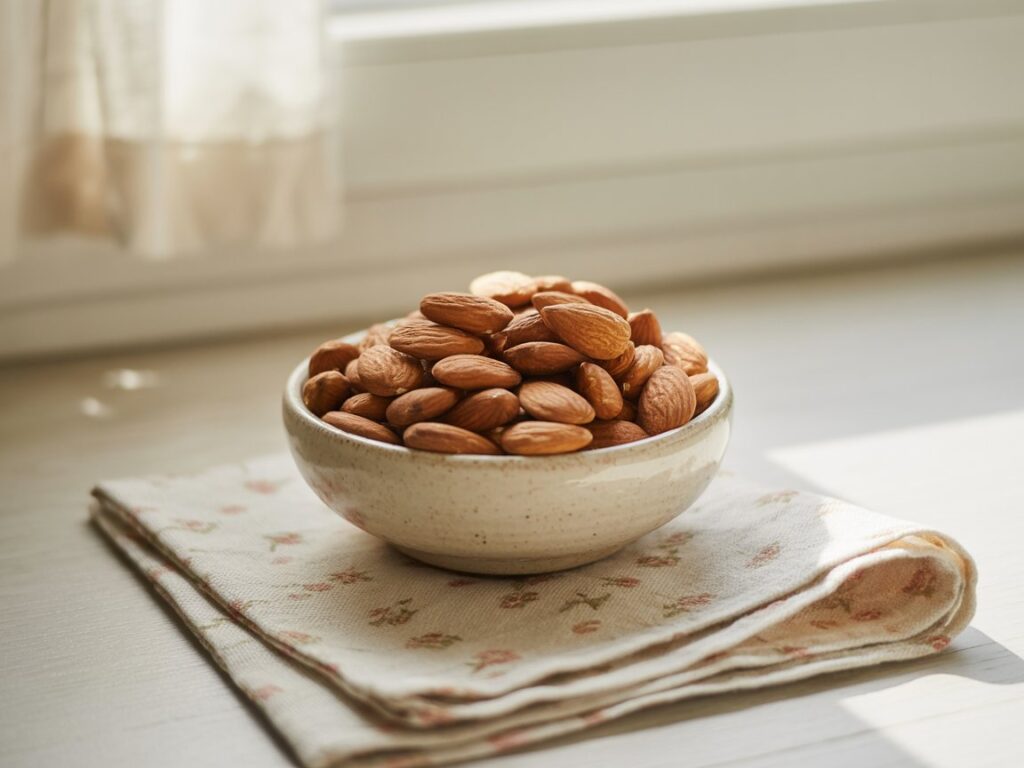
Almonds are one of the most nutrient-dense nuts you can add to your diet, and they play a powerful role in supporting weight management, heart health, and muscle recovery. Small but mighty, these crunchy nuts are packed with protein, fiber, healthy fats, and essential vitamins that work together to keep your body energized and satisfied throughout the day.
Why Almonds Are a Smart Choice for Health & Fitness
Almonds are naturally rich in healthy monounsaturated fats, which are the same type of fats found in olive oil. These fats are known to support heart health, improve cholesterol levels, and help regulate blood sugar. Unlike refined carbs that cause energy crashes, almonds provide steady fuel, making them a great option for curbing hunger between meals.
One serving (about a small handful or 23 almonds) contains roughly 6 grams of protein and 4 grams of fiber. This combination helps keep you full longer, which is crucial if your goal is weight loss or avoiding late-night snacking. The protein also supports muscle repair and recovery, especially if you eat almonds as a post-workout snack or add them to meals after exercise.
Key Nutrients in Almonds
- Vitamin E: A powerful antioxidant that protects your cells from oxidative stress and promotes healthy skin.
- Magnesium: Important for muscle function, energy production, and regulating blood sugar levels.
- Calcium: Supports strong bones and teeth, especially when paired with other calcium-rich foods.
These nutrients make almonds more than just a snack—they’re a functional food that can help reduce inflammation, promote better heart health, and even improve workout performance.
Almonds for Weight Loss and Energy
One of the reasons almonds are so effective for weight control is their ability to reduce cravings. The combination of protein, fiber, and healthy fats helps stabilize blood sugar levels, preventing the sudden energy dips that often lead to overeating. Some research even suggests that incorporating almonds into your daily diet can enhance fat-burning during workouts.
If you often find yourself reaching for chips, candy, or other processed snacks, swapping them for almonds is a simple yet effective step toward healthier eating.
The Best Ways to Add Almonds to Your Diet
Almonds are versatile and can be enjoyed in many different ways without feeling repetitive. Here are a few ideas:
- On-the-Go Snack: Carry a small portion in a resealable bag to have a healthy option when hunger strikes.
- Smoothie Booster: Add almond butter or a handful of almonds to your smoothies for extra creaminess and protein.
- Salad Topper: Sprinkle chopped almonds over leafy green salads for crunch and a nutrient boost.
- Greek Yogurt Pairing: Combine almonds with Greek yogurt and fruit for a high-protein, balanced snack.
- Almond Milk: Swap regular milk with unsweetened almond milk in coffee, oatmeal, or smoothies for fewer calories.
The Bottom Line
Almonds may be small, but their impact on health and fitness is significant. They provide lasting energy, protect your heart, and help manage weight when eaten in moderation.
By including almonds as part of a balanced diet, you’ll have a nutrient-packed snack that satisfies cravings while fueling your body with the vitamins and minerals it needs to perform at its best.
8. Eggs

Eggs are often called “nature’s multivitamin” — and for good reason. They are one of the most complete and affordable sources of protein available, making them a staple food for anyone looking to build muscle, lose fat, or simply maintain good health.
Packed with high-quality protein, essential vitamins, and healthy fats, eggs are versatile and can be enjoyed at any meal of the day.
Why Eggs Are a Superfood for Health & Fitness
Each egg contains around 6–7 grams of complete protein, meaning it provides all nine essential amino acids that your body cannot produce on its own.
This makes eggs especially valuable for muscle repair and recovery after workouts, as well as for supporting lean body mass during weight loss.
Eggs are also rich in healthy fats, which help keep you full and provide long-lasting energy.
Contrary to old beliefs that linked eggs to heart problems, modern research shows that moderate egg consumption can actually support healthy cholesterol levels and reduce the risk of heart disease for most people.
Key Nutrients in Eggs
Eggs offer a wide variety of essential vitamins and minerals that many people fall short on:
- Choline: Important for brain health, memory, and nervous system function.
- Vitamin D: Supports strong bones, immunity, and hormone balance.
- Vitamin B12: Crucial for energy production and red blood cell formation.
- Selenium: A powerful antioxidant that helps protect your cells.
- Lutein & Zeaxanthin: Antioxidants that support eye health and may reduce the risk of age-related vision problems.
Most of these nutrients are concentrated in the egg yolk, which is why eating whole eggs (not just egg whites) provides the greatest benefits.
Eggs for Weight Loss and Muscle Building
Because of their protein and fat balance, eggs are incredibly filling. Studies show that starting your day with eggs for breakfast can reduce overall calorie intake throughout the day by keeping you satisfied longer.
This makes them a great choice if your goal is weight loss or avoiding unhealthy snacks.
For athletes or anyone focused on building muscle, eggs provide the amino acids needed for recovery and growth.
Pairing eggs with a carbohydrate source, like whole-grain toast or oatmeal, makes for an ideal post-workout meal.
The Best Ways to Eat Eggs
One of the biggest advantages of eggs is their versatility. Here are a few healthy, easy, and delicious ways to add them to your meals:
- Boiled: Perfect as a grab-and-go snack or sliced into salads.
- Scrambled or Omelet: Add vegetables, herbs, or a sprinkle of cheese for a nutrient-packed meal.
- Poached: Great on top of avocado toast or grain bowls.
- Baked: Use in frittatas or egg muffins for meal prep.
- Egg Whites + Yolks Combo: For those watching calories, use two egg whites plus one whole egg to keep protein high while slightly reducing fat.
The Bottom Line
Eggs are one of the most nutrient-rich foods you can eat, offering a powerful combination of protein, healthy fats, vitamins, and antioxidants.
Whether your goal is fat loss, muscle growth, or simply better health, eggs are a must-have in your diet. Their versatility, affordability, and nutritional profile make them an easy superfood to enjoy daily.
9. Sweet Potatoes

Sweet potatoes are one of the most nutrient-rich and versatile carbohydrates you can include in your diet. Unlike regular potatoes, sweet potatoes are packed with vitamins, minerals, and antioxidants that make them a healthier choice for long-lasting energy, muscle recovery, and overall wellness.
Their naturally sweet flavor, satisfying texture, and nutritional benefits make them a staple food for both fitness enthusiasts and anyone trying to maintain a balanced diet.
Why Sweet Potatoes Are a Smart Carb
Carbohydrates often get a bad reputation, but they’re essential for fueling your body and brain. Sweet potatoes are a complex carbohydrate, meaning they digest slowly and provide steady energy rather than causing blood sugar spikes.
This makes them ideal for athletes, people looking to lose weight, or anyone who wants to avoid mid-day crashes after meals.
In addition to providing energy, sweet potatoes are rich in dietary fiber, which helps promote satiety, supports digestion, and balances blood sugar levels.
This makes them a great option if you want to manage cravings while keeping your meals both filling and nutritious.
Key Nutrients in Sweet Potatoes
Sweet potatoes are packed with essential nutrients that benefit the whole body:
- Beta-Carotene (Vitamin A): Supports eye health, immune function, and healthy skin.
- Vitamin C: Boosts immunity, collagen production, and wound healing.
- Potassium: Helps regulate blood pressure, fluid balance, and muscle function.
- Manganese: Supports metabolism and bone health.
- Fiber: Aids digestion and keeps you fuller for longer.
This nutrient density makes sweet potatoes a true “super carb” that nourishes your body beyond just calories.
Sweet Potatoes for Weight Loss & Fitness
For anyone trying to lose weight, sweet potatoes are a powerful ally. Their high fiber content keeps you satisfied and prevents overeating, while their low glycemic index means they release energy slowly, avoiding the spikes and crashes caused by refined carbs.
For athletes or gym-goers, sweet potatoes are perfect as a pre-workout or post-workout carb. They replenish glycogen stores (your body’s fuel for exercise) while also delivering vitamins and minerals that aid muscle recovery.
Paired with a protein source like chicken, salmon, or eggs, they make a balanced meal that supports both performance and recovery.
The Best Ways to Eat Sweet Potatoes
One of the best things about sweet potatoes is their versatility in the kitchen. Here are some delicious and healthy ways to enjoy them:
- Baked: Simple and filling—just bake until soft and top with cinnamon, nut butter, or Greek yogurt.
- Mashed: A lighter alternative to mashed white potatoes, especially when made with olive oil instead of butter.
- Roasted: Tossed in olive oil and herbs, roasted sweet potatoes are a perfect side dish.
- Fries: Homemade baked sweet potato fries are a healthier alternative to fast-food fries.
- In Soups or Stews: Adds natural sweetness and thickness to hearty dishes.
- In Smoothies: Blended cooked sweet potato adds creaminess and a nutrient boost.
The Bottom Line
Sweet potatoes are one of the healthiest carbohydrate sources you can add to your diet. They provide steady energy, support weight management, aid workout recovery, and deliver a wide range of essential vitamins and minerals.
Whether baked, roasted, or mashed, sweet potatoes are a delicious and nourishing choice that can easily fit into any meal plan.
10. Broccoli
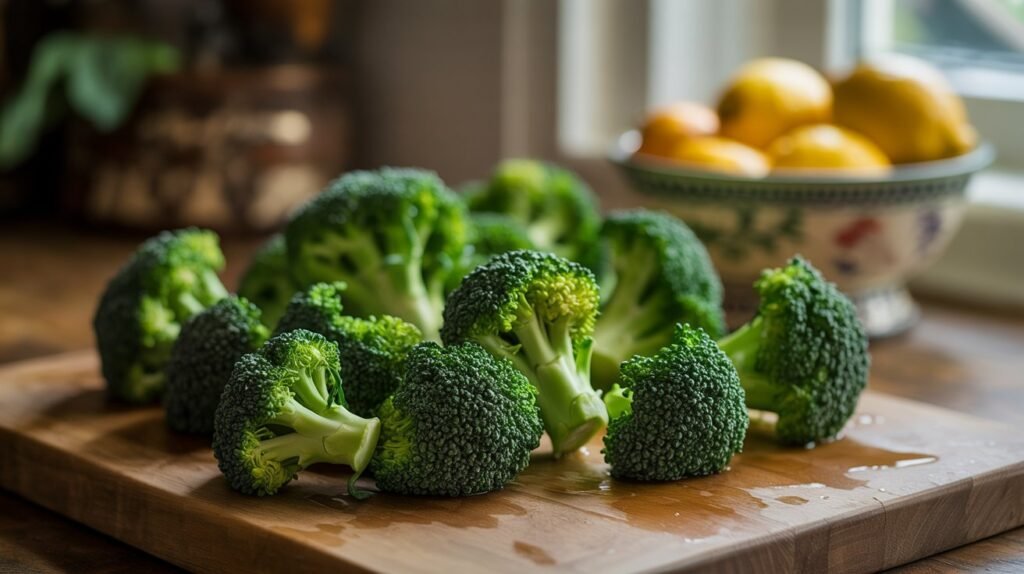
Broccoli is often called a nutritional powerhouse — and for good reason. This green cruciferous vegetable is packed with vitamins, minerals, antioxidants, and fiber, all while being very low in calories.
Whether your goal is fat loss, muscle building, or simply eating a nutrient-dense diet, broccoli deserves a permanent spot on your plate.
Why Broccoli Stands Out
Broccoli is unique because it combines low calories with high nutrient density. One cup of cooked broccoli has fewer than 60 calories but delivers an impressive amount of vitamin C, vitamin K, folate, potassium, and fiber.
This makes it a perfect option if you want to eat large, satisfying portions without overloading on calories.
On top of that, broccoli contains powerful plant compounds like sulforaphane, which has been studied for its anti-inflammatory, detoxifying, and even cancer-fighting properties.
It’s one of those foods that not only supports weight management but also protects your long-term health.
Key Nutrients in Broccoli
Here are some of the biggest nutritional highlights of broccoli:
- Vitamin C: Strengthens the immune system, promotes healthy skin, and supports collagen production.
- Vitamin K: Essential for blood clotting and bone health.
- Folate: Important for cell growth and energy metabolism.
- Fiber: Aids digestion, balances blood sugar, and keeps you full.
- Potassium: Helps regulate blood pressure and muscle function.
- Sulforaphane: A unique antioxidant compound that may protect against chronic diseases.
Broccoli for Weight Loss & Fitness
For weight loss, broccoli is a top performer. It’s high in fiber and water content, meaning it fills you up without adding many calories.
Eating broccoli regularly can help control appetite and reduce overall calorie intake while still giving your body the nutrients it needs.
For fitness, broccoli plays an important role too. The antioxidants reduce exercise-related inflammation, while its potassium content supports muscle contractions and recovery.
The high vitamin C levels also help combat oxidative stress, which can build up during intense workouts.
The Best Ways to Eat Broccoli
One of broccoli’s strengths is its versatility in the kitchen. It can be eaten raw, steamed, roasted, or added to a wide range of meals. Here are some ideas:
- Steamed or Roasted: A simple side dish with olive oil, garlic, and a pinch of salt.
- Stir-Fried: Cooked quickly with lean protein like chicken or shrimp for a balanced meal.
- Blended into Soups: Adds creaminess and extra nutrition to blended vegetable soups.
- In Omelets or Scrambles: Pair with eggs for a nutrient-rich breakfast.
- Raw with Dips: A crunchy snack option with hummus or Greek yogurt dip.
The Bottom Line
Broccoli is more than just a side vegetable — it’s a superfood that delivers a wide range of health benefits while being incredibly low in calories.
It supports weight management, workout recovery, and long-term health through its combination of vitamins, minerals, and antioxidants.
By making broccoli a regular part of your diet, you’re giving your body the fuel it needs to perform well today and stay healthy for years to come.
11. Oats
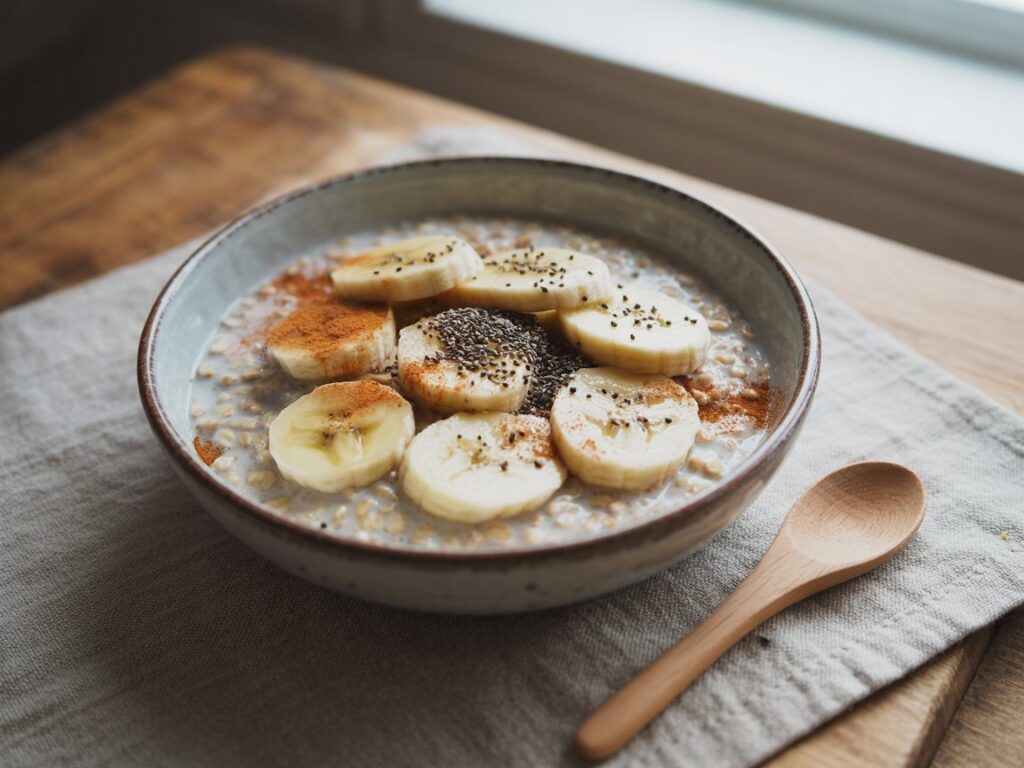
Oats are one of the most affordable, filling, and nutrient-rich whole grains you can add to your diet.
They’ve earned a reputation as a “super carb” because they provide steady energy, support heart health, and promote satiety — all while being versatile enough to enjoy in both sweet and savory dishes.
If your goal is weight loss, fitness, or simply improving your diet, oats deserve a spot in your daily routine.
Why Oats Are a Nutrition Staple
Unlike refined grains, oats are a whole grain that retains their fiber, vitamins, and minerals.
The standout nutrient in oats is beta-glucan, a special type of soluble fiber known for lowering cholesterol, improving digestion, and stabilizing blood sugar levels.
Oats also provide a balanced source of complex carbohydrates and protein, making them excellent for both long-lasting energy and muscle recovery. They digest slowly, which means you feel fuller for longer — helping to prevent overeating or mid-day energy crashes.
Key Nutrients in Oats
Oats are much more than just a carb source. They pack in a wide range of nutrients, including:
- Beta-Glucan Fiber: Reduces cholesterol and supports gut health.
- Manganese: Important for metabolism and bone health.
- Magnesium: Supports energy production and muscle function.
- Iron: Helps transport oxygen in the blood, reducing fatigue.
- B Vitamins (Thiamin, Folate, etc.): Boost energy and aid metabolism.
- Protein: Around 5–6 grams per serving, which is high for a grain.
This nutrient density makes oats an excellent choice for overall health, weight management, and fitness performance.
Oats for Weight Loss & Fitness
If you’re looking to manage your weight, oats are one of the best breakfast or snack options. The fiber helps you feel satisfied, which curbs cravings and prevents mindless snacking.
Studies show that oats can improve satiety more than other cereals, making them particularly effective for calorie control.
For fitness, oats are a go-to pre-workout food because they provide a steady release of energy. They fuel your body without causing spikes and crashes in blood sugar.
Post-workout, they pair perfectly with protein (like Greek yogurt or a protein shake) to restore glycogen stores and support recovery.
The Best Ways to Eat Oats
Oats are incredibly versatile and can be customized to suit your taste. Here are some healthy, delicious ways to enjoy them:
- Overnight Oats: Mix oats with milk or Greek yogurt, add fruit, nuts, or seeds, and leave in the fridge overnight.
- Warm Oatmeal: Cook oats with water or milk and top with berries, almond butter, or cinnamon.
- Baked Oats: A cake-like breakfast option made by baking blended oats with eggs, fruit, or protein powder.
- Savory Oats: Cook with broth and top with eggs, avocado, or vegetables for a hearty, non-sweet option.
- Smoothie Booster: Blend a handful of oats into smoothies for thickness and added fiber.
The Bottom Line
Oats are one of the simplest yet most powerful foods for improving your diet. They’re nutrient-dense, budget-friendly, and adaptable to countless recipes.
With their ability to support heart health, stabilize blood sugar, and provide long-lasting energy, oats are an essential part of a balanced diet.
Whether enjoyed in a bowl of oatmeal, baked into a healthy treat, or blended into a smoothie, oats are a true superfood that can help you meet your health and fitness goals.
12. Lentils
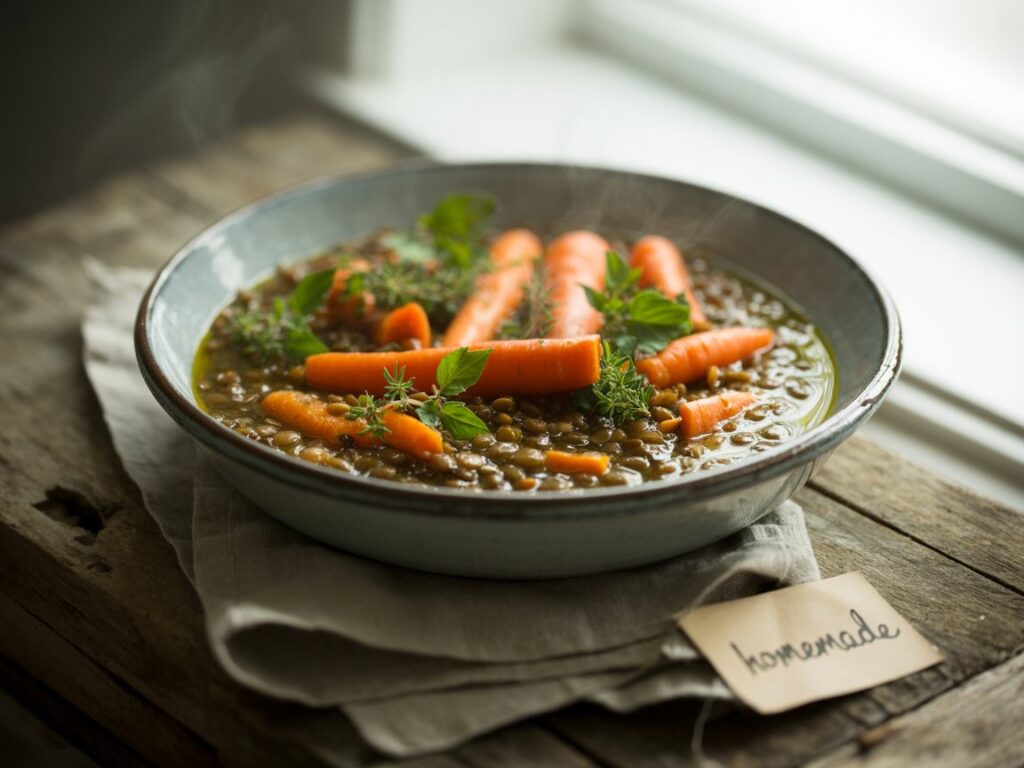
Lentils are one of the most underrated superfoods — affordable, versatile, and packed with nutrition.
As a plant-based powerhouse, they provide a unique balance of protein, complex carbohydrates, fiber, and essential minerals.
Whether your goal is weight loss, muscle building, or simply eating a more balanced diet, lentils can easily fit into your meals while delivering long-lasting benefits.
Why Lentils Are a Plant-Based Superfood
Lentils are part of the legume family and stand out for their high protein content, making them an excellent meat alternative for vegetarians and vegans.
Just one cup of cooked lentils contains about 18 grams of protein, which is impressive for a plant-based food.
They’re also rich in complex carbohydrates and fiber, which provide steady energy and keep you feeling satisfied for hours.
Another major advantage of lentils is their affordability and accessibility. They’re widely available, budget-friendly, and can be stored dry for long periods, making them a practical staple for any kitchen.
Key Nutrients in Lentils
Lentils deliver an impressive range of vitamins and minerals, including:
- Protein: Supports muscle repair, recovery, and growth.
- Fiber: Aids digestion, balances blood sugar, and promotes fullness.
- Iron: Essential for oxygen transport and preventing fatigue.
- Folate: Important for energy metabolism and healthy cell growth.
- Magnesium & Potassium: Support muscle function, heart health, and blood pressure regulation.
- Antioxidants: Help reduce inflammation and protect against chronic diseases.
This combination of nutrients makes lentils a functional food that benefits both short-term energy and long-term health.
Lentils for Weight Loss & Fitness
For weight loss, lentils are an excellent choice because they are low in calories but high in protein and fiber. This means you can eat a satisfying portion without consuming excess calories.
Their slow-digesting carbohydrates also help regulate blood sugar levels, preventing energy crashes and cravings.
For fitness, lentils provide plant-based protein that supports muscle recovery and strength building. Paired with grains like rice or quinoa, they form a complete protein, supplying all essential amino acids.
This makes them especially valuable for anyone following a vegetarian or vegan diet.
The Best Ways to Eat Lentils
Lentils are incredibly versatile and can be cooked in countless ways, from soups to salads. Here are some ideas to include them in your meals:
- Lentil Soup or Stew: A hearty and warming dish, perfect for meal prep.
- Lentil Salad: Combine with fresh vegetables, olive oil, and herbs for a protein-packed salad.
- Lentil Curry: Cook with spices, coconut milk, and vegetables for a flavorful, filling meal.
- Lentil Tacos or Burgers: A creative way to replace ground meat in classic dishes.
- Side Dish: Serve alongside lean proteins or whole grains for a complete, balanced plate.
The Bottom Line
Lentils may be small, but their nutritional value is enormous. They’re one of the best plant-based sources of protein and fiber, making them ideal for weight management, muscle recovery, and overall health.
Affordable, versatile, and nutrient-dense, lentils are a simple yet powerful food that can elevate your diet and keep you fueled for the long run.
13. Chia Seeds
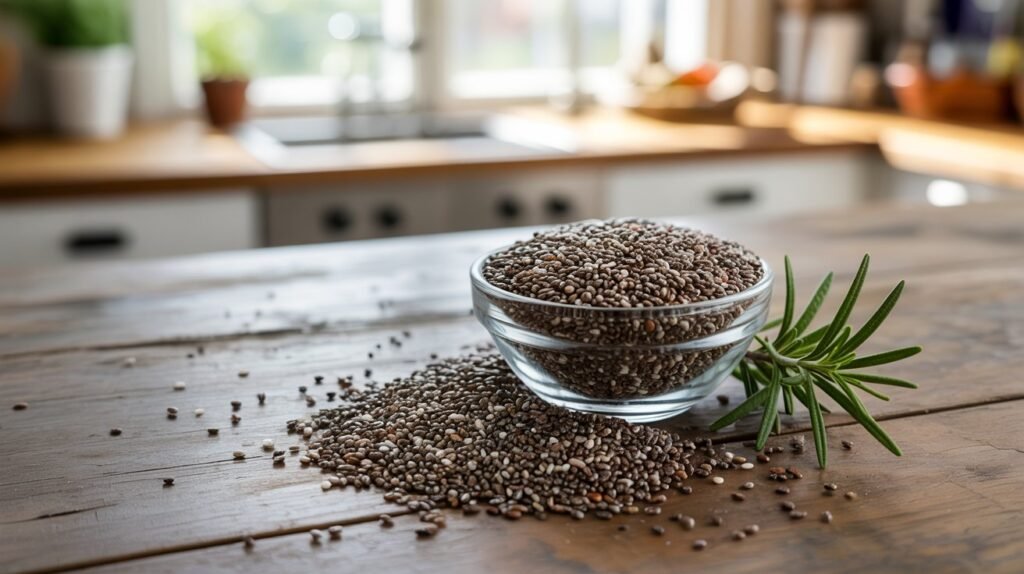
Chia seeds may be tiny, but they are one of the most nutrient-dense foods you can include in your diet.
They have been called a “superfood” for good reason—offering a powerhouse of protein, healthy fats, fiber, vitamins, and minerals that directly support both fitness goals and overall health.
Rich Source of Plant-Based Protein
Protein is essential for repairing muscle tissue and supporting lean muscle growth, especially after strength training or high-intensity workouts.
Just two tablespoons of chia seeds provide about 5 grams of protein, making them an excellent choice for vegetarians, vegans, and anyone looking to increase their protein intake naturally.
Since they also contain all nine essential amino acids, chia seeds are considered a complete protein—something rare for plant-based foods.
High Fiber Content for Satiety and Weight Control
Chia seeds are extremely rich in soluble fiber. This type of fiber absorbs water and expands in your stomach, slowing digestion and promoting feelings of fullness.
This makes them ideal for people who want to reduce cravings, manage their appetite, and control calorie intake without feeling deprived.
The slow digestion also helps stabilize blood sugar levels, preventing sudden spikes and crashes that can lead to fatigue or overeating.
Omega-3 Fatty Acids for Recovery
Unlike most plant foods, chia seeds are a notable source of omega-3 fatty acids (specifically ALA—alpha-linolenic acid).
These healthy fats reduce inflammation in the body, which is particularly beneficial after workouts when muscles and joints need recovery. Lower inflammation can mean less soreness and faster muscle repair.
Antioxidants for Muscle Protection
Chia seeds are loaded with antioxidants that protect your body from free radical damage caused by exercise and environmental stress.
This protective effect supports long-term muscle health and overall wellness, while also helping slow down signs of aging.
Hydration Benefits
One unique quality of chia seeds is their ability to absorb 10–12 times their weight in water, forming a gel-like consistency.
When consumed, this gel helps your body stay hydrated and may even improve endurance during long workouts. Many athletes use chia-based drinks to maintain hydration and energy.
How to Add Chia Seeds to Your Diet
The best part about chia seeds is their versatility. They have a mild flavor that blends well with both sweet and savory dishes. Here are a few easy ways to include them in your meals:
- Mix into smoothies or protein shakes for extra nutrition.
- Stir into Greek yogurt, oats, or cottage cheese for added crunch and fiber.
- Make chia pudding by soaking them in milk or almond milk overnight.
- Sprinkle over salads, soups, or roasted vegetables for a nutrient boost.
- Use them as a baking ingredient in healthy muffins, breads, or energy bars.
Why Chia Seeds Matter for Fitness
For anyone focused on fitness, chia seeds provide a unique combination: they fuel your muscles with protein, help regulate appetite with fiber, keep your joints and tissues healthy with omega-3s, and aid recovery with antioxidants.
Whether your goal is to build strength, lose weight, or improve endurance, adding chia seeds to your diet can be a small change that makes a big difference.
14. Green Tea

Green tea is more than just a comforting hot beverage—it’s a powerful health booster and one of the most effective natural drinks for supporting weight loss, improving energy, and enhancing overall wellness.
For centuries, it has been used in Asian cultures not only for its calming qualities but also for its wide range of health benefits.
Today, science confirms what tradition has long suggested: green tea is one of the best drinks you can add to your daily routine if you’re focused on fitness, metabolism, and long-term health.
Rich in Antioxidants and Catechins
One of the main reasons green tea is so beneficial is its extremely high content of antioxidants, particularly a group called catechins.
The most powerful of these is EGCG (epigallocatechin gallate), which has been studied extensively for its ability to reduce inflammation, protect cells from damage, and promote fat burning.
These antioxidants also help slow down aging at the cellular level and may lower the risk of chronic diseases.
Boosts Metabolism and Fat Burning
Perhaps the most popular benefit of green tea is its ability to increase calorie burning and fat oxidation.
Studies show that drinking green tea or taking green tea extract can help the body burn more calories at rest and during exercise.
This is partly due to the combination of caffeine and EGCG, which work together to enhance thermogenesis (the body’s process of generating heat and burning fat).
For people trying to lose belly fat or stubborn cellulite, green tea can provide a natural metabolic boost.
Provides Clean, Steady Energy
Unlike coffee, which can sometimes cause jitters and sudden crashes, green tea provides a smoother, more balanced source of energy.
It contains caffeine, but in moderate amounts, and is paired with L-theanine, an amino acid that promotes calm focus and relaxation.
This makes green tea a great choice before a workout, while studying, or during long work hours when you need energy without overstimulation.
Supports Workout Recovery
The anti-inflammatory properties of green tea make it helpful for muscle recovery after intense workouts.
Drinking green tea regularly can help reduce soreness, ease joint stiffness, and support faster healing at the cellular level.
Athletes and fitness enthusiasts often include green tea in their post-workout routine for its recovery benefits.
Aids Digestion and Gut Health
Green tea can also support healthy digestion by balancing gut bacteria and reducing bloating.
Its mild caffeine content acts as a natural digestive aid, while its antioxidants support a healthy gut lining.
If you struggle with water retention or feel sluggish after meals, a warm cup of green tea can help you feel lighter and more energized.
How to Add Green Tea to Your Diet
The versatility of green tea makes it easy to include in your daily lifestyle:
- Drink it hot in the morning instead of coffee for a gentler energy boost.
- Enjoy it iced with lemon for a refreshing low-calorie drink.
- Add it to smoothies by steeping green tea and blending it with fruits.
- Try matcha powder, which contains the whole green tea leaf and offers an even higher concentration of antioxidants.
- Use it post-workout to speed up recovery and hydration.
Why Green Tea Belongs in Your Fitness Plan
For anyone aiming to lose weight, improve focus, or simply live a healthier lifestyle, green tea is an easy win.
It helps with fat loss, boosts metabolism, aids digestion, supports recovery, and provides long-term protection against oxidative stress.
Unlike many supplements, it’s natural, affordable, and enjoyable to drink daily.
In short: green tea isn’t just a beverage—it’s a tool for better health, improved performance, and sustainable weight management.
15. Brown Rice
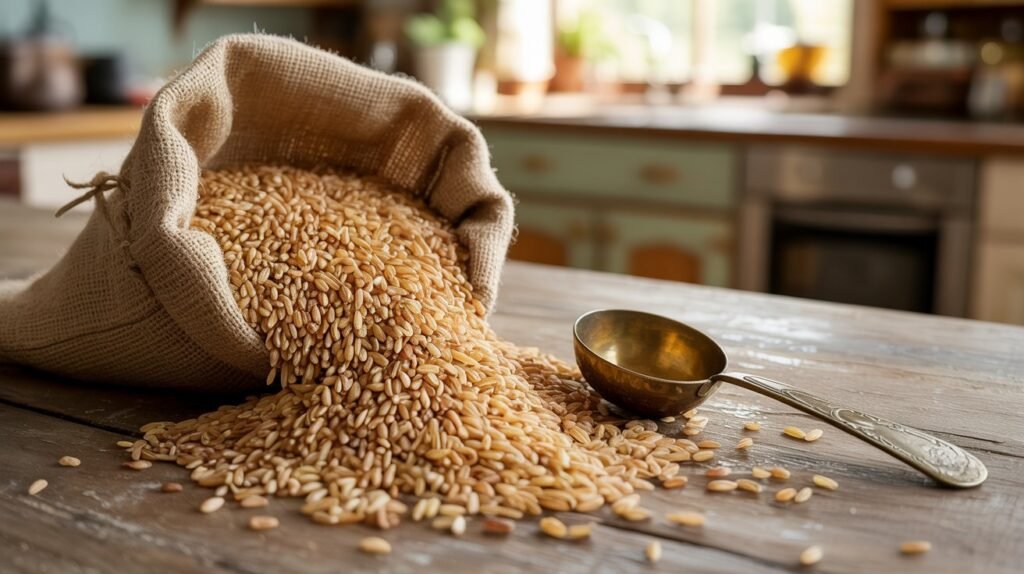
Brown rice is often called a “whole-grain powerhouse”, and for good reason. Unlike white rice, which has been stripped of its outer bran and germ layers during processing, brown rice keeps its bran and germ intact.
This makes it far more nutrient-dense and beneficial for fitness, weight management, and overall health.
A Rich Source of Complex Carbohydrates
Carbohydrates are your body’s main source of energy, and not all carbs are created equal.
Brown rice is a complex carbohydrate, meaning it digests slowly and provides a steady release of energy rather than the quick spikes and crashes you get from refined carbs.
This makes it especially useful for athletes, gym-goers, and anyone who wants sustained fuel for workouts and daily activities.
High in Fiber for Digestion and Satiety
One of the biggest advantages of brown rice is its high fiber content. Fiber plays a key role in keeping your digestive system healthy, regulating blood sugar levels, and promoting fullness after meals.
By slowing down digestion, brown rice helps prevent overeating and reduces the chances of mid-day cravings. For those focused on weight loss or maintaining a healthy diet, fiber-rich foods like brown rice are invaluable.
Packed with Essential Nutrients
Brown rice is much more than just a carb source. It provides:
- Magnesium – crucial for muscle function, energy production, and bone strength.
- Manganese – supports metabolism, antioxidant defense, and hormone balance.
- Selenium – aids in thyroid function and immune support.
- B vitamins (like niacin, riboflavin, and folate) – help convert food into energy and support nervous system health.
These nutrients work together to fuel your body, making brown rice an excellent staple for both active and everyday lifestyles.
A Heart-Healthy Grain
Because it’s rich in fiber and low in unhealthy fats, brown rice can help reduce cholesterol levels and support cardiovascular health.
Regularly replacing refined carbs with whole grains like brown rice has been linked to lower risks of heart disease, type 2 diabetes, and obesity.
Fitness Benefits of Brown Rice
For people who exercise regularly, brown rice provides a balanced source of energy and recovery nutrients:
- The slow-digesting carbs help power long workouts and endurance training.
- The fiber keeps you feeling satisfied, making it easier to stick to a clean diet.
- The magnesium and antioxidants support muscle recovery and reduce inflammation after exercise.
Many bodybuilders and athletes choose brown rice as a “go-to carb” because it provides clean fuel without causing unnecessary fat gain.
Easy Ways to Add Brown Rice to Your Diet
Brown rice is versatile and can easily replace white rice or pasta in meals. Here are some ideas:
- Serve it as a base for stir-fries, curries, or lean protein dishes.
- Mix it with vegetables and beans for a fiber-packed, plant-based meal.
- Use it in grain bowls or meal prep containers with chicken, salmon, or tofu.
- Cook extra and keep it in the fridge to use in soups, salads, or wraps.
- Pair it with eggs and avocado for a hearty post-workout meal.
Why Brown Rice Belongs in Your Nutrition Plan
If you’re looking for a food that fuels your body, aids recovery, and supports long-term health, brown rice deserves a permanent place on your plate.
It provides lasting energy, keeps you full, nourishes your body with key vitamins and minerals, and promotes both fitness performance and weight control.
In short: brown rice is not just a side dish—it’s a foundation for a balanced, healthy, and active lifestyle.
16. Carrots
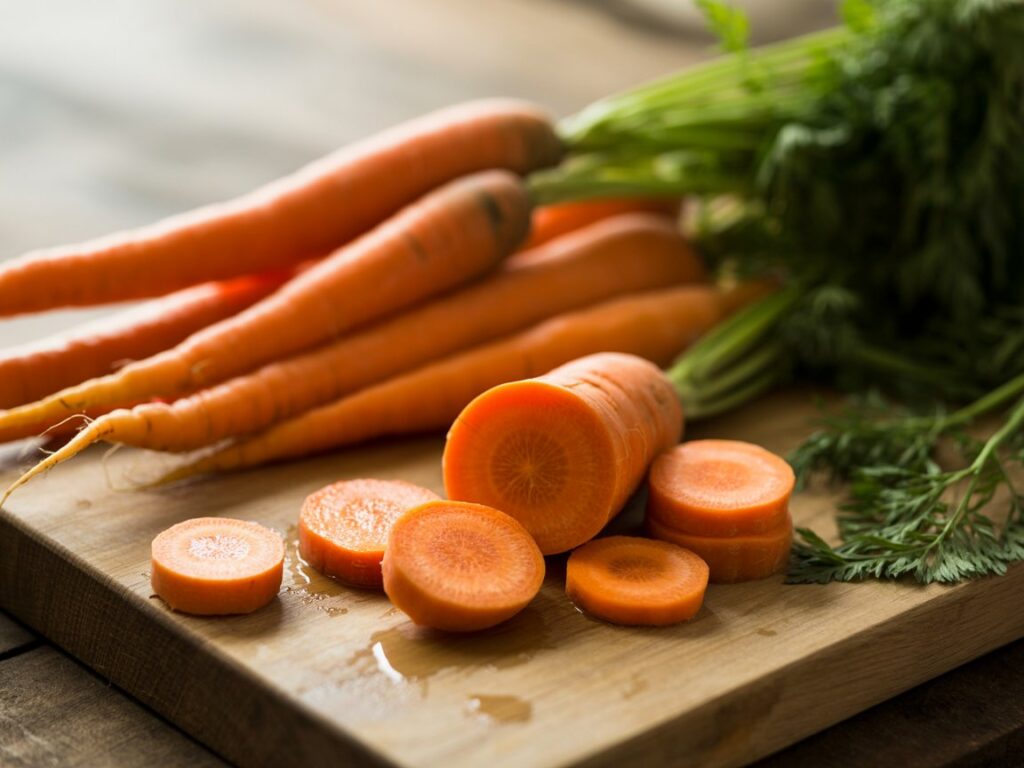
Carrots are one of the most well-known and widely eaten vegetables, but they are far more than just a crunchy snack.
Packed with vitamins, minerals, antioxidants, and fiber, carrots support everything from eye health to workout recovery.
Because they are low in calories yet high in essential nutrients, carrots are an ideal food for people who want to stay fit, energized, and healthy without sacrificing flavor.
Rich in Vitamin A and Beta-Carotene
Carrots are best known for their beta-carotene content, a plant pigment that your body converts into vitamin A. Vitamin A is crucial for eye health, immune system strength, and skin vitality.
For active individuals, it also supports healthy cell growth and repair, which is important after exercise. A single medium carrot can provide more than 200% of your daily vitamin A needs.
A Low-Calorie, High-Nutrient Snack
If you’re trying to maintain or lose weight, carrots are an excellent choice. One cup of raw carrots contains only about 50 calories, yet provides fiber, vitamin C, potassium, and antioxidants.
Because they are crunchy and filling, they can help satisfy cravings for chips or other high-calorie snacks while keeping you on track with your nutrition goals.
Antioxidants for Inflammation and Recovery
Carrots aren’t just about vitamin A—they also contain powerful antioxidants like lutein, zeaxanthin, and polyphenols.
These compounds help fight oxidative stress in the body, which can build up after intense workouts or daily stress.
By reducing inflammation and protecting your cells, carrots play a role in quicker recovery and long-term health.
Heart and Gut Health Benefits
The fiber and potassium in carrots work together to support cardiovascular health. Potassium helps regulate blood pressure, while fiber helps lower cholesterol levels and keeps digestion smooth.
Eating fiber-rich vegetables like carrots also feeds the good bacteria in your gut, which improves digestion and boosts immunity.
Fitness-Friendly Fuel
While carrots are not a major source of protein or fat, they are a clean, natural carbohydrate source.
The natural sugars in carrots are released slowly thanks to their fiber, making them a steady source of energy before workouts.
Pairing carrots with a protein-rich food (like hummus, Greek yogurt dip, or cottage cheese) creates a balanced snack that fuels workouts and aids recovery.
Easy Ways to Enjoy Carrots
Carrots are extremely versatile and can be eaten raw, cooked, or even juiced. Here are some simple ways to add them to your meals:
- Eat raw carrot sticks with hummus or Greek yogurt dip as a healthy snack.
- Add shredded carrots to salads, wraps, or sandwiches for extra crunch.
- Roast carrots with olive oil, garlic, and herbs for a flavorful side dish.
- Use carrots in soups, stews, and stir-fries for added nutrition.
- Blend carrots into smoothies or juices for a natural sweetness boost.
Why Carrots Should Be in Your Diet
Carrots are an affordable, widely available, and nutrient-packed food that supports nearly every aspect of health.
From improving eyesight and boosting immunity to supporting workout recovery and keeping your weight in check, carrots are a small food with a big impact.
In short: carrots are more than just a side vegetable—they are a powerful tool for better health, energy, and fitness.
17. Apples
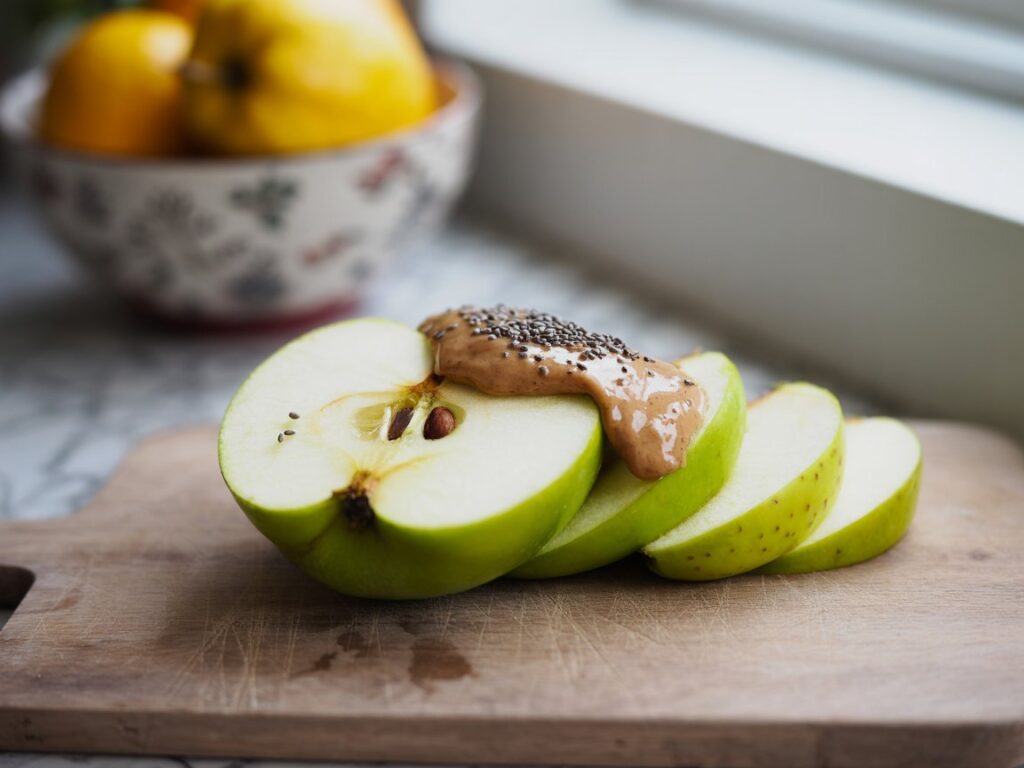
The saying “an apple a day keeps the doctor away” exists for a reason. Apples are one of the most widely consumed fruits in the world, and they’re packed with nutrients that support weight management, fitness performance, heart health, and overall well-being.
With their crisp texture, natural sweetness, and versatility, apples are a smart addition to any diet.
A Low-Calorie, High-Nutrient Snack
Apples are naturally low in calories but high in important vitamins, minerals, and antioxidants.
A medium apple contains roughly 95 calories, 4 grams of fiber, and 25 grams of natural carbohydrates, making it a balanced snack that provides both quick energy and long-lasting satiety.
Because of their volume and crunch, apples help curb hunger without adding excess calories.
High in Fiber for Satiety and Gut Health
One of the biggest benefits of apples is their high fiber content, especially soluble fiber known as pectin.
Pectin slows digestion, stabilizes blood sugar levels, and helps you feel full for longer periods of time.
This makes apples an excellent food for weight control and appetite management. Fiber also supports a healthy gut by feeding good bacteria and improving digestion.
Natural Energy Boost
Thanks to their natural sugars (fructose, sucrose, and glucose), apples provide a quick energy lift without the crash associated with processed snacks.
This makes them perfect as a pre-workout snack, giving you just enough fuel to power through exercise without feeling heavy.
Pairing an apple with protein (like peanut butter, almonds, or Greek yogurt) creates a balanced mini-meal that supports both energy and muscle recovery.
Antioxidants That Protect Your Health
Apples are rich in polyphenols and flavonoids, powerful antioxidants that help fight inflammation and protect your cells from oxidative damage.
This can reduce muscle soreness after workouts, improve heart health, and even lower the risk of chronic diseases.
Studies also suggest that apples may support lung function and reduce the risk of asthma—an added bonus for anyone with respiratory concerns during exercise.
Heart and Blood Sugar Benefits
Apples are especially beneficial for heart health. The soluble fiber helps lower LDL cholesterol, while the antioxidants reduce blood pressure and improve vascular function.
Despite being sweet, apples have a low glycemic index, meaning they don’t spike blood sugar levels as much as refined carbs. This makes them a safe choice even for those managing blood sugar.
Easy Ways to Add Apples to Your Diet
Apples are one of the easiest fruits to incorporate into your meals. Here are some simple ideas:
- Eat them raw as a quick, portable snack.
- Slice and pair with peanut butter or almond butter for a protein-rich combo.
- Add diced apples to oatmeal, salads, or yogurt bowls.
- Bake apples with cinnamon for a warm, healthy dessert.
- Blend into smoothies or fresh juices for natural sweetness.
- Use apple slices as a crunchy topping for sandwiches or wraps.
Why Apples Deserve a Spot in Your Diet
Apples are affordable, widely available year-round, and incredibly versatile. Whether you’re looking to lose weight, fuel your workouts, or simply improve your health, apples deliver big benefits in a small package.
They provide lasting energy, fiber for satiety, antioxidants for recovery, and essential nutrients for overall wellness.
In short: apples are not just a snack—they’re a complete health booster that supports both fitness goals and long-term well-being.
18. Tomatoes
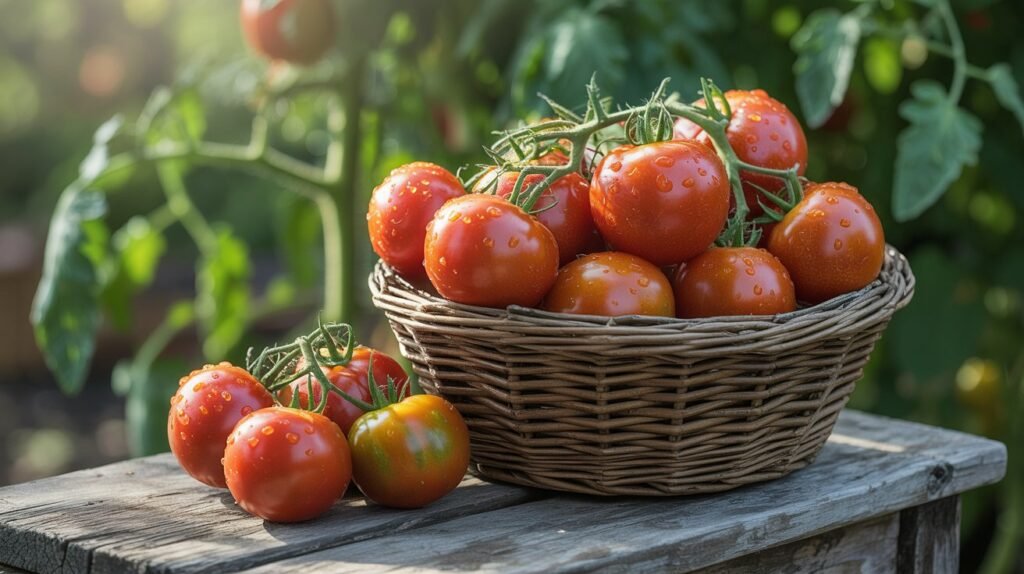
Tomatoes are often thought of as just a salad ingredient or a base for sauces, but they are actually one of the most nutrient-rich and versatile foods you can add to your diet. Packed with vitamins, minerals, antioxidants, and hydration benefits, tomatoes support everything from heart health and skin glow to muscle recovery and weight management. Whether eaten raw, cooked, or blended, tomatoes bring both flavor and function to your meals.
Rich in Antioxidants – Especially Lycopene
The standout nutrient in tomatoes is lycopene, a powerful antioxidant responsible for their red color. Lycopene has been linked to reduced inflammation, improved heart health, and even cancer protection. For people who exercise regularly, lycopene also helps combat oxidative stress caused by workouts, speeding up recovery and protecting muscle tissue. Interestingly, cooked tomatoes (like tomato sauce or roasted tomatoes) actually provide higher levels of lycopene than raw tomatoes, making them even more beneficial.
Vitamin-Packed for Overall Health
Tomatoes are a great source of essential vitamins and minerals, including:
- Vitamin C – boosts immunity and helps repair tissues after workouts.
- Vitamin A – supports vision, skin health, and immune function.
- Potassium – regulates fluid balance, blood pressure, and muscle contractions.
- Folate – important for energy production and cell growth.
This mix of nutrients makes tomatoes a full-body health booster.
Low in Calories, High in Hydration
Tomatoes are about 95% water, making them an excellent hydrating food. This is particularly useful for athletes or anyone who sweats heavily during exercise. At the same time, they are very low in calories (around 25 calories per medium tomato), which makes them a perfect addition to a weight-loss or weight-maintenance diet.
Heart Health Benefits
Tomatoes are strongly linked to cardiovascular health. Lycopene, potassium, and fiber all work together to lower blood pressure, reduce bad cholesterol, and improve circulation. A diet rich in tomatoes and other antioxidant-rich vegetables has been associated with a lower risk of heart disease and stroke.
Skin and Anti-Aging Benefits
The combination of lycopene and vitamin C makes tomatoes a natural skin-boosting food. Lycopene protects skin from sun damage, while vitamin C promotes collagen production, helping skin stay firm and youthful. Regular consumption of tomatoes can contribute to clearer, healthier-looking skin.
Fitness-Friendly Fuel
For fitness enthusiasts, tomatoes provide several advantages:
- They replenish electrolytes thanks to potassium.
- Their antioxidants reduce post-workout soreness.
- They are a light carb source that can be paired with protein for recovery meals.
Some athletes even drink tomato juice post-workout for rehydration and anti-inflammatory benefits.
Easy Ways to Add Tomatoes to Your Diet
Tomatoes are incredibly versatile and can be enjoyed in countless ways:
- Slice them raw into salads, wraps, or sandwiches.
- Roast or grill them for a flavorful side dish.
- Use them as a base for soups, stews, or pasta sauces.
- Blend into smoothies or juices for a nutrient-packed drink.
- Pair with mozzarella and basil for a classic Caprese salad.
Why Tomatoes Deserve a Place on Your Plate
Tomatoes are affordable, widely available, and nutrient-dense. They hydrate your body, protect your heart, improve skin health, and speed up workout recovery—all while being low in calories and delicious.
Whether you prefer them raw, cooked, or juiced, tomatoes are a true superfood for health, fitness, and everyday wellness.
In short: tomatoes are more than just a salad ingredient—they’re a daily essential for long-term health and peak performance.
19. Turmeric
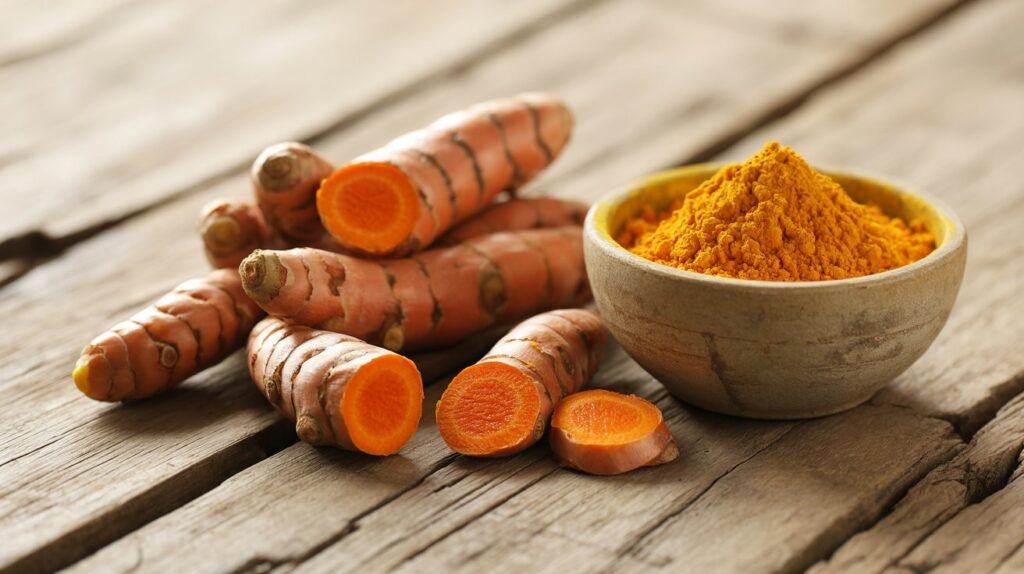
Turmeric is more than just a golden spice that adds color and flavor to your meals—it’s one of the most powerful natural ingredients for health and wellness.
Used for centuries in traditional medicine, turmeric is best known for its active compound curcumin, which has strong anti-inflammatory, antioxidant, and healing properties.
For anyone focused on fitness, weight management, or long-term health, turmeric is a natural powerhouse that deserves a regular spot in your diet.
Curcumin: The Secret Power of Turmeric
The real magic of turmeric comes from curcumin, the bioactive compound that gives turmeric its vibrant yellow-orange color.
Curcumin has been widely studied for its ability to fight inflammation, protect cells from damage, and support recovery.
Since chronic inflammation is linked to issues like joint pain, fatigue, and even weight gain, including turmeric in your daily meals can be a simple way to promote overall wellness.
Anti-Inflammatory and Joint Support
For athletes and active individuals, turmeric’s anti-inflammatory properties are especially beneficial. Regular exercise can lead to muscle soreness, joint stiffness, or minor inflammation.
Curcumin helps reduce these effects, supporting faster recovery and improving flexibility. Many people also use turmeric to naturally manage conditions like arthritis or joint discomfort.
A Natural Antioxidant Boost
Workouts and daily stress create free radicals in the body, which can damage cells and speed up aging. Turmeric provides a strong dose of antioxidants that neutralize free radicals and protect your muscles, skin, and organs from oxidative stress.
This makes it an excellent food for long-term health and vitality.
Supports Digestive and Metabolic Health
Turmeric is known to aid digestion by stimulating bile production and reducing bloating. It also supports healthy metabolism, which can assist in weight management.
Some studies suggest that turmeric may even help regulate blood sugar levels, making it beneficial for people who want to maintain steady energy throughout the day.
Heart and Brain Benefits
Beyond fitness, turmeric supports heart and brain health. Its anti-inflammatory and antioxidant effects can reduce the risk of cardiovascular disease by improving circulation and lowering cholesterol levels.
Curcumin has also been linked to better memory, focus, and mood, making it a brain-boosting spice as well.
How to Get the Most Out of Turmeric
One important thing to know about turmeric is that curcumin isn’t absorbed easily on its own. To maximize its benefits, always pair turmeric with:
- Black pepper (contains piperine, which increases absorption by up to 2,000%).
- Healthy fats like olive oil, coconut oil, or avocado (curcumin is fat-soluble).
Easy Ways to Add Turmeric to Your Diet
Turmeric is versatile and can be added to a variety of dishes and drinks:
- Sprinkle into soups, curries, stir-fries, or roasted vegetables.
- Add to scrambled eggs, rice, or quinoa for extra flavor and color.
- Blend into smoothies, juices, or protein shakes.
- Make a warm “golden milk latte” by mixing turmeric with milk, cinnamon, and honey.
- Take as a turmeric supplement (with black pepper extract) if you want a higher daily dose.
Why Turmeric Deserves a Spot in Your Nutrition Plan
Turmeric is more than just a spice—it’s a natural healer. It reduces inflammation, supports recovery, boosts brain power, and protects your body from long-term damage.
For anyone pursuing fitness goals or simply wanting to stay healthy, turmeric is an easy, affordable, and powerful addition to your daily routine.
In short: turmeric is a golden secret for better health, stronger recovery, and long-lasting vitality.
20. Dark Chocolate

Dark chocolate—specifically varieties that contain 70% or more cocoa—is one of the rare foods that can be both indulgent and incredibly healthy.
Unlike milk chocolate or heavily processed candy bars, dark chocolate is rich in antioxidants, fiber, and essential minerals like iron, magnesium, and zinc. Its most powerful compounds are flavonoids, particularly epicatechin, which have been linked to improved blood circulation, reduced inflammation, and better cardiovascular health.
These benefits make dark chocolate not just a guilty pleasure but a functional food that supports your overall wellness.
From a weight loss perspective, dark chocolate can be surprisingly effective. Because of its intense, slightly bitter taste, just a small piece is often enough to satisfy cravings for something sweet.
This can help you avoid overindulging in sugary, calorie-dense desserts that contribute to weight gain.
Dark chocolate also contains fiber, which slows digestion, stabilizes blood sugar levels, and promotes satiety, meaning you feel full for longer periods after eating it. This makes it easier to control portion sizes throughout the day.
Another lesser-known benefit of dark chocolate is its effect on stress and mood regulation. Consuming it in moderation can reduce cortisol (the stress hormone), helping to prevent emotional eating and fat storage around the midsection.
It also contains small amounts of caffeine and theobromine, which can give you a gentle energy boost and improve focus without the crash that comes from sugary snacks.
For those who are mindful of calories, portion control is essential. Dark chocolate is nutrient-dense but also calorie-dense, so eating too much can backfire.
The key is to enjoy it strategically: one or two squares a day can provide health benefits while still keeping your diet on track.
How to Eat It:
- Have 1–2 small squares after lunch or dinner as a satisfying dessert.
- Shave or grate dark chocolate over oatmeal, Greek yogurt, or chia pudding for a nutrient boost.
- Blend a small piece into smoothies for a rich, chocolaty flavor.
- Pair with fruit, like strawberries or bananas, for a healthy, balanced snack.
Pro Tip: Always choose chocolate that is at least 70% cocoa or higher. The higher the cocoa percentage, the greater the antioxidant content and the lower the sugar.
Avoid varieties with added caramel, nougat, or other sugary fillers, as these eliminate most of the health benefits.
When enjoyed responsibly, dark chocolate proves that you don’t have to give up all indulgences to maintain a healthy diet and achieve your weight loss goals—it can be both a treat and a tool in your journey toward better health.
FAQs: Eating Healthy
1. What does “eating healthy” actually mean?
Eating healthy means choosing nutrient-dense foods that provide your body with vitamins, minerals, protein, fiber, and healthy fats while limiting processed foods high in sugar, sodium, and unhealthy oils. It’s not about strict rules or deprivation—it’s about balance, portion control, and making sustainable food choices.
2. Can I still eat my favorite foods and be healthy?
Yes! Eating healthy doesn’t mean you have to cut out all your favorite foods. The key is moderation. You can enjoy pizza, burgers, or sweets occasionally, as long as most of your diet consists of whole foods like vegetables, fruits, lean proteins, and whole grains. Think of the 80/20 rule: eat healthy 80% of the time, and leave 20% for treats.
3. Do I need to follow a specific diet to be healthy?
Not necessarily. While diets like the Mediterranean diet, plant-based diet, or high-protein diet can help guide your eating, you don’t need a label to be healthy. Focus on eating whole, minimally processed foods and building meals that include protein, healthy fats, and complex carbs. What works best often depends on your lifestyle and preferences.
4. Is eating healthy expensive?
It doesn’t have to be. While some health foods are pricey, many affordable staples—like oats, lentils, brown rice, beans, eggs, and seasonal produce—are budget-friendly and highly nutritious. Planning meals ahead of time, buying in bulk, and cooking at home can save money while keeping your diet healthy.
5. How can I start eating healthy if I’m a beginner?
Start small. Instead of changing your entire diet overnight, try these simple steps:
- Add a vegetable to every meal.
- Replace sugary drinks with water or green tea.
- Choose whole grains (like brown rice or quinoa) instead of refined carbs.
- Snack on nuts, fruit, or yogurt instead of chips or candy.
- Cook at home more often to control ingredients.
These small changes add up and create sustainable habits.
6. Do I need to cut out carbs to lose weight?
No. Carbs are not the enemy. What matters is the type of carbs you eat. Whole grains, fruits, vegetables, and legumes provide fiber and essential nutrients, while refined carbs (white bread, pastries, sugary snacks) can spike blood sugar and lead to cravings.
Instead of cutting carbs completely, focus on choosing healthier sources.
7. How important is portion size when eating healthy?
Very important. Even healthy foods can lead to weight gain if eaten in large amounts. For example, nuts, avocado, and olive oil are full of healthy fats but are also calorie-dense. Practicing portion control ensures you get the benefits of these foods without overdoing it.
8. Is it better to eat 3 big meals or 5–6 small meals a day?
It depends on your body and lifestyle. Some people feel more satisfied eating three balanced meals, while others prefer smaller, frequent meals to keep energy levels stable. What matters most is total calorie intake and nutrient quality, not meal frequency.
9. Can eating healthy really help me lose weight?
Yes. A healthy diet naturally supports weight loss by:
- Reducing cravings for processed foods.
- Balancing blood sugar levels.
- Providing fiber that keeps you fuller for longer.
- Supporting metabolism with protein and nutrient-rich foods.
When combined with regular exercise and good sleep, eating healthy is one of the most effective and sustainable ways to lose weight.
10. How do I stay consistent with eating healthy?
Consistency comes from building habits, not restrictions. Plan meals ahead, keep healthy snacks available, and allow yourself flexibility. Remember, it’s not about perfection—it’s about making better choices most of the time. Over time, these choices become your normal lifestyle.
Conclusion: Eating Healthy Made Simple
Eating healthy isn’t about strict diets, cutting out entire food groups, or trying to be perfect. It’s about making better daily choices that nourish your body, fuel your energy, and support long-term health.
The 20 foods we covered—ranging from avocados and leafy greens to salmon, quinoa, dark chocolate, and more—are proof that healthy eating can be both nutritious and enjoyable.
By building your meals around whole foods that are rich in fiber, protein, antioxidants, and healthy fats, you give your body the tools it needs to burn fat more efficiently, balance hormones, and keep cravings in check.
Small swaps—like choosing brown rice instead of white rice, or snacking on almonds instead of chips—add up to big results over time.
The key takeaway is this: you don’t need to follow a complicated plan or deprive yourself to eat well. Focus on balance, variety, and portion control, and remember that even little improvements can create lasting change.
Whether your goal is weight loss, improved energy, or simply feeling better in your own skin, eating healthy is the most sustainable path forward.
Start today with one simple change—add a leafy green to lunch, swap soda for green tea, or keep a bowl of apples on your counter for quick snacking.
Over time, these habits will become second nature, and you’ll see just how powerful eating healthy can be for your body and mind.

